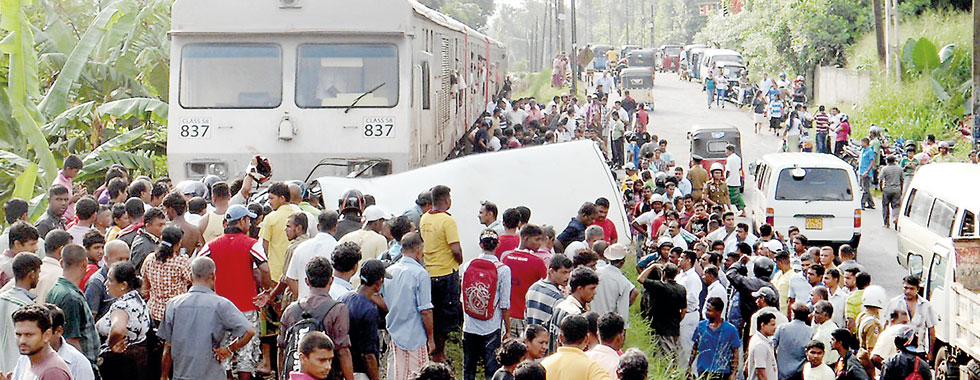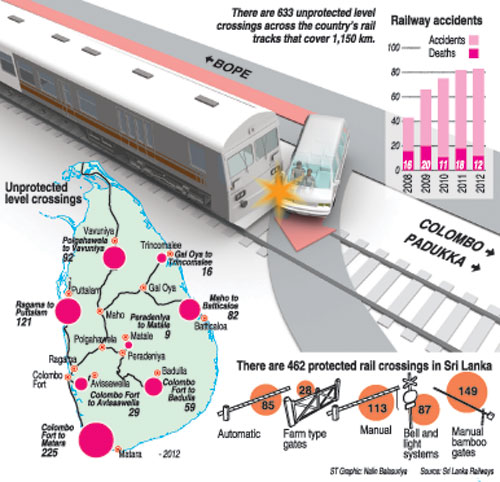News
Killer crossings result of new roads heedlessly built across tracks
Railways Dept disputes onus for providing protection
Five-year-old Rasindu Malsara had been in love with trains, and with his nursery situated close to the rail track he used to run to the window at the distant hoot of a train whistle to watch for the approaching locomotives. The little boy would never have imagined that a train would claim his life. He was one of the victims in last week’s train-van collision in Padukka when the school van in which he was travelling was crushed by the Colombo-bound train from Avissawella at an unprotected rail crossing in Arukwatte, Padukka.
The driver, who had dropped off about 23 children, met with the accident on the return journey to drop Rasindu. Manel Nayana, who witnessed the tragedy, said she had shouted at the driver, Anjana Hemantha, to warn him about the approaching train. Ms. Nayana, who runs the nursery Rasindu used to attend, said the van had stalled on the track and that while Mr. Hemantha had been trying to grab the child and get out of the van the train had rammed into the vehicle.

The scene of the crash at Padukka. Pix by S. Siriwardhene
On Wednesday evening, seven people narrowly escaped death by jumping out of a Dimo lorry just before it collided with a train at the Sirappuankuliya unprotected rail crossing in Chilaw. A group of six young women, including a bride-to-be, had been visiting friends to hand over wedding invitations and were returning home when the accident took place. The driver too had managed to jump out of the vehicle.
The lorry had been badly damaged and was dragged for about 50 metres. Last month, about 25 people were injured when an express train rammed into a packed bus at an unprotected railway crossing at Rockland Junction, Beruwala. The injured were returning after attending a funeral in Galle.
While the death toll fluctuates, the number of unprotected railway accidents has been increasing. In 2008, there were 43 accidents and 16 deaths. In 2010, this increased to 75 accidents and 11 deaths. In 2011, the number of accidents was recorded as 82 with eight deaths, and in 2012, 83 accidents were reported, with 12 deaths.
The country’s total railway tracks cover 1450km, but with some of the northern line currently non-operational, the working tracks amount to 1150km. The highest number of unprotected level crossings is along the coastal railway line from Colombo Fort to Galle – 225. Statistics issued last year by the Railways Department show there are 121 unprotected crossings on the Ragama-Puttalam line, 92 on the Polgahawela-Vavuniya line, 81 on Maho-Batticoloa line, nine on Peradeniya-Matale line, 59 on Colombo-Badulla main line, 29 along the Kelani Valley (Maradana-Avissawella) and 16 along Gal-Oya to Trincomalee.
Out of the 1083 level crossings in the country, 85 have automatic rail gates, 113 mechanical gates, 28 farm gates, 87 bell-and-light gates and 149 bamboo gates. Additional General Manager of the Department of Railways, Nalaka Bandara, said that about one-third of the 621 unprotected level crossings were scheduled to be safe-guarded by the end of the year.
“Rail crossings, including the Beruwala, Rockland junction crossing at which a packed bus collided with a train in April, are scheduled to be protected within the next four months,” Mr. Bandara said. Tenders for most of these were yet to be approved by the Cabinet. “The most urgent tenders have been approved and work on 45 crossings has commenced,” Mr. Bandara said.
“At present, work is complete at 12 crossings on the Kelani Valley line and 11 crossings on the Negombo line.” Work on the other 22 crossings should be completed within the next four months. The Department of Railways was aiming to complete protection at crossings on the Northern line, Talaimannar line, the Southern coastal line and the Matara- Beliatta line according to the level of vehicular traffic, with protection levels varying from alarm bells and signal lights to full gated protection.

At present, all level crossings at main roads and triple line crossings island-wide have been protected with signal lights, warning alarms and barriers, Mr. Bandara said, adding that drivers of motor vehicles should take responsibility for their safety and show caution whenever they spot a flashing sign of an unprotected level crossing ahead. “Engine drivers sound the horn when nearing crossings, so vehicle drivers should at least pay more attention to that sound.” he added.
The minimum cost of constructing a simple system of a signal light and warning bell was Rs.4.5 million and an electronic barrier with a signal light and warning alarm cost Rs.6 million, Operating Superintendent of Railways, L.A.R. Ratnayake said. Former senior railways officials interviewed for this article stressed that the Railways Department could not bear the entire responsibility for fixing unprotected rail crossings nor for the motor accidents that occur at them.
“I don’t believe that the Railways Department alone should bear the cost of protecting all level crossings, because it is not the department or the rail user who benefits from the level crossings,” said Mr. Priyal Silva, a former general manager of the department.
It was the road user who benefited from the crossings, so where unprotected crossings exist, the local provincial councils and pradeshiya sabhas should help protect the crossing.
Dr Lalithasiri Gunaruwan, another former departmental general manager, echoed Mr. Silva’s statement. “I believe that the Road Development Authority, provincial councils and local authorities should be responsible for the protection of level crossings,” he said. “They could tax the road users if they want.”
He added that according to a clause in the Railway Ordinance, trains always had priority at any crossing; whoever used a level crossing should do so at his or her own risk. “Crossing a railway line is just like crossing a junction or coming to a main road from a by-lane. It is up to the driver of the vehicle to see if there is a train on the line before crossing. The Department of Railways should not be blamed if vehicle drivers are not careful at level crossings.” he said.
Dr. Gunaruwan said that according to the Railway Ordinance, the Railways Department had to provide protection for a crossing only if a railway line was being laid across an existing road. He added that in the early 1900s, when rail lines were laid across the country, all crossings that went across the existing roads were protected by the Department of Railways. The department was not responsible for level crossing protection of roads that were built across existing railway lines. “These unprotected level crossings are, in fact, a hindrance to rail users. If you take the Southern coastal line, there are crossings at almost every kilometre,” Dr. Gunaruwan said.
“The department has spent so much to get sophisticated fast trains for these tracks and modernising the tracks, but because of these crossing the trains are never able to reach their full speed.
“The trains have to slow down at the unprotected crossings because the engine drivers don’t know if there are vehicles across the line, and then the trains get late and the rail users are inconvenienced.” If the department was forced to spend any more on protecting crossings, the cost of this would have to added to the price of the ticket of the poor rail user who could not afford a car.
Dr. Gunaruwan said that even though, from time to time, the department tried to use low-cost protection mechanisms at unprotected crossings, these were not successful. “We tested some low-cost precaution methods for unprotected level crossings in low rail traffic areas.
“First we tried using mirrors so that vehicle drivers can see an oncoming train from a distance, but this failed because the local children threw stones at the mirrors and they broke. “Then we tried polished steel instead of the mirrors, but the drug-addicts of the areas stole the steel to pay for their drugs, and that also failed.” Dr. Gunaruwan said.
“The visibility of the track is another issue. Politically created villages and slums obscure the crossings from drivers: they can’t even see the lines, let alone the oncoming trains. New unprotected crossings are put across existing tracks to enter these new villages. These are all very dangerous.
“These crossings should not be created. The Railways Department can’t do anything to stop them or to clear the area because the local and central government politicians get involved and the department has no power them,” he said. The Secretary of the All-Ceylon Railway Employees General Union (ACREGU), Sumathipala Manawadu, agreed that local government politicians should be blamed for making unprotected level crossings instead of focusing on proper road development.
“While it is the responsibility of the Railways Department to give priority for safety, local governments should not be allowed to build unprotected level crossings,” Mr. Manawadu said.
Cheap, safe and local solutions on offer
The Sunday Times, under the title “Unappreciated efforts”, carried an article in January about the invention of a low-cost signal system to prevent accidents at unprotected level crossings. Dr. Sarath Wimalasuriya, a medical doctor who is also a keen inventor, had built the prototype signal system.
“I sent a registered letter to the Minister of Transport on December 2012 and personally went and handed over a letter to department onJanuary 02. I have got more than 2000 calls from the public, but not a single official from the Railways Department or a politician contacted me,” Dr Wimalasuriya said.
Commenting on the Railways Department estimates for the cost a signal system being Rs.4 million rupees for a light-and-bell system and Rs.6 million for a barrier and signal system, Dr Wimalasuriya said, “I can show them that this can be done locally, without foreign tenders.
“It costs about Rs.1 million. If the authorities are not happy with solar power they can use power from the electricity supply and have battery backup,” he said. The Railways Department says it has called for tenders from local manufacturers following several media reports on inventions of low-cost signal systems.
“We are going for local purchases once safety is tested,” said Chief Signalling Engineer Palitha Samarasinghe. “Although solar-powered signal systems are not reliable we are hoping to include them in tests before making a purchasing decision,” he said.
Follow @timesonlinelk
comments powered by Disqus

